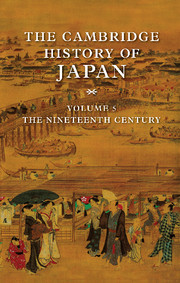Book contents
- Frontmatter
- Introduction
- 1 Japan in the early nineteenth century
- 2 The Tempō crisis
- 3 Late Tokugawa culture and thought
- 4 The foreign threat and the opening of the ports
- 5 The Meiji Restoration
- 6 Opposition movements in early Meiji, 1868–1885
- 7 Japan's turn to the west
- 8 Social change
- 9 Economic change in the nineteenth century
- 10 Meiji political institutions
- 11 Meiji conservatism
- 12 Japan's drive to great-power status
- Works Cited
- Index
- References
6 - Opposition movements in early Meiji, 1868–1885
Published online by Cambridge University Press: 28 March 2008
- Frontmatter
- Introduction
- 1 Japan in the early nineteenth century
- 2 The Tempō crisis
- 3 Late Tokugawa culture and thought
- 4 The foreign threat and the opening of the ports
- 5 The Meiji Restoration
- 6 Opposition movements in early Meiji, 1868–1885
- 7 Japan's turn to the west
- 8 Social change
- 9 Economic change in the nineteenth century
- 10 Meiji political institutions
- 11 Meiji conservatism
- 12 Japan's drive to great-power status
- Works Cited
- Index
- References
Summary
Like all the great revolutions of the modern era, the Meiji Restoration generated intense opposition from groups and classes displaced and disadvantaged by revolutionary change. What sets the Meiji Restoration apart, however, is the apparent ease with which opposition to the revolutionary regime was defeated or co-opted. Peasant riots over the new conscription law, village protests against the land tax revision, revolts by disaffected samurai, early campaigns for representative government, and uprisings by dispossessed farmers all were contained or suppressed. The original leadership group stayed in charge and did not change its basic policies. Viewed positively, Japan enjoyed extraordinary continuity and stability in government; viewed negatively, conservative and bureaucratic politics prevailed.
Japanese and Western historians disagree sharply when explaining the failure of opposition movements to oust the ruling oligarchy or force changes in its agenda. Scholars in America and Great Britain influenced by modernization theory have generally viewed Japan as a model of peaceful transition from feudalism to modernity, a transformation in which core values of consensus and loyalty to emperor kept dissent within manageable bounds. On the other hand, most Japanese and some Western historians credit the failure of the opposition movements to the authoritarian character of the Meiji state, emphasizing the incorporation of oppressive semifeudal structures into the Meiji polity and the oligarchy's control of the new state's efficient state security apparatus.
- Type
- Chapter
- Information
- The Cambridge History of Japan , pp. 367 - 431Publisher: Cambridge University PressPrint publication year: 1989
References
- 28
- Cited by

